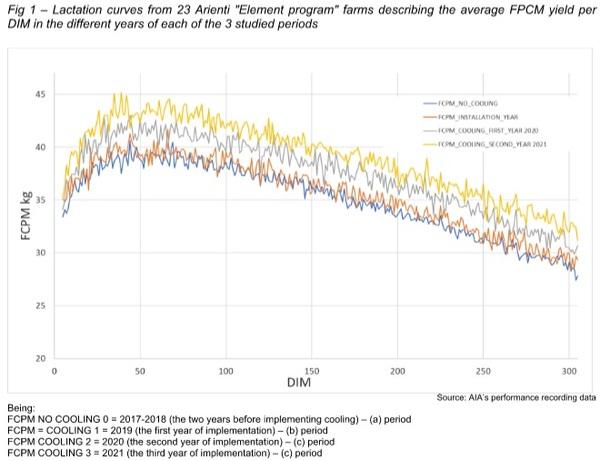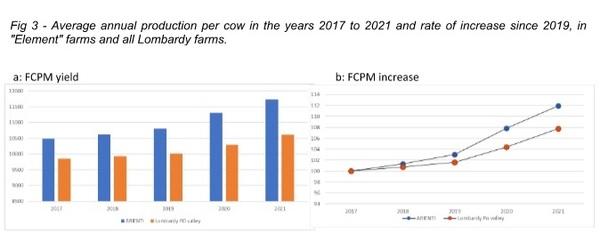The Italian dairy sector is learning how to cope with summer heat stress
Published: January 11, 2023
By: Israel Flamenbaum 1, Alessia Tondo 2, Dario Pasetti 3 / 1 Cow Cooling Solutions, Ltd; 2 A.I.A, Italian Assoc. Cattle Breeders; 3 Arienti Co.
According to the Italian website CLALIT, in 2021 the Italian dairy sector accounted for almost 10% of the total EU milk production and 6% of EU milk exports. Italy exports nearly 35% of its milk production, mostly cheese, with high added value to the milk. Italian dairy herd consists of 1.6 million dairy cows, most of them in farms located in the Po valley region, in the north of the country. Milk production in 2021 reached 13.2 billion litres, when per cow annual milk production is 8,300 litres, 3.76% fat and 3.44% protein. Annual milk production in 2021 was almost 4% above that of the year before, more than double the increase in 2020 (1.7%) and in 2019 (1.3%).
In one of the last publications on the CLALIT website, we found that the increase in annual production is unique to Italy, and that the same magnitude does not appear in other important milk produces in the EU, like Germany, France and Holland, as can be seen in the graphics below.

As can be seen in the figures above, milk production in 2021 in these countries was lower than the two previous years, mostly in the summer–autumn months, while milk production in Italy was higher than in previous years, along all year time.
There is no clear explanation for this phenomenon. Anyhow, we will speculate a bit in this article, and relate, at least part of this unusual increase in cow’s performance in Italy, to the adoption, and proper implementation of cow cooling means, in more and more dairy farms in Italy in recent years, where we honestly feel that we took some part. The first professional visit of Dr. Flamenbaum to Italy was in March 2016, providing lectures on cow cooling in different parts of the country. The collaboration with Arienti company started at the end of 2016, after which, consultancy and professional support program, named “Element” program, was established, where cooling equipment has been installed and farm results evaluated, by company technical staff. Follow-up includes the use of intra-vaginal data loggers, and the calculation of the “summer to winter ratio index” (that, in collaboration with AIA, the Italian Association of dairy farmers). During these years, Dr. Flamenbaum participated as lecturer in two consecutive “Cirio” national dairy farmers meetings (2017 and 2018), in a special workshop on the cow cooling topic, and four “one week” visits every year to farms and institutions, bringing together with Arienti people, the “cow cooling message” in a direct form to dairy farmers all over Italy.
In order to support the “speculations” on the contribution of the “cow cooling campaign” to national milk production improvement (as presented at the beginning of this article), data from 23 dairy farms that participated in Element program, have been investigated in depth, where some important results have been achieved. These farms (most of them in Lombardy), started implementing intensive cooling in summer 2019, and keep doing it till these days. The farms were visited by company technicians during summer, and were confirmed as “properly cooling” farms. In order to understand last year’s improvement in Italian farm production, we decided to compare Element farms results to those of almost 2,000 Frisian cows’ dairy farms in Lombardy Po valley region. Using the performance recording data of AIA, the comparison of annual lactation curves and monthly averages of per cow FPCM (fat and protein corrected milk) production have been calculated. For the evaluation and comparison, annual cow’s performance was calculated over three periods: (a) two years before the cooling program started (2017-2018), (b) the year when cooling was first implemented (2019), and (c) the two years after (2020-2021). Lactation curves and total milk yields in the different three periods are presented. In fig 1, for Element farms and in fig 2, for all Lombardy farms.

The improvement from 2017 to 2018, was 170 kg (+1.62%), and can be considered as “annual regular trend of improvement” which include both, genetic and management improvements. If we calculate the difference between 2019 (first summer of cooling) to 2018, the difference is 210 kg, only 40 kg above the “regular” improvement. Anyhow, when we compare 2020 and 2021, each to previous year we had an increase of 435 and 420 kg of milk, respectively, which is much above the increase in previous years. As published in a previous article, it is quite clear that the improvement in cow’s performance is not completed in the year of implementation, but “keeps on growing” for at least two summers more.
The annual “genetic” (defined by Milk Index), and “non-genetic” improvement per cow in these farms was calculated and compared between the periods before and after cooling was implemented. Between 2019 and 2021, there was a total annual increase of 1,176 kg FCPM per cow, out of which, 346 kg were considered as expected genetic increase, and 830 kg (almost double), were considered as “non-genetic” increase (be aware that the implementation of intensive cooling was one of the sole changes done in these farms, in this period of time). We are curious to see whether this tendency continues, and, in case it does, until when, and at what rate.
Now, let's see what happened in the same period, in the rest of Lombardy (Po valley region, approximately 2,000 farms). The trend in production in the same years can be seen in fig 2.

As can be seen, also Lombardy farms experienced a remarked increase in per cow annual milk production in 2020 and 2021, which is much above the observed in the years before. We can assume that, as with Element farms, the increase in production in these years in Lombardy farms is above the expected genetic improvement. In figure 3a and 3b, we compare the rate of increase obtained between 2017 and 2021, in the 23 Element farms to that obtained in all Lombardy.

From the presented in figure 3a, there is an increase in cow’s annual production in the last three years, in both, Element and all Lombardy farms. The rate of increase in the entire period (2017-2021), was almost 50% greater in Element farms, as compared to all Lombardy farms (1,250 and 766 kg FPCM kg), respectively. Since 2019 (the first year of cooling implementation in Element farms), milk production increased by 1,109 kg in Element farms (10.4%), as compared to 690 kg (6.9%), in all Lombardy farms, more than double. The change in the magnitude of the increase in annual milk production in both “Element” and all Lombardy farms, starting in 2019, can be seen in figure 3b.
The increase observed in the production in Element farms can be well understood, as the proper installation and operation of cooling means since summer 2019 could be confirmed by Arienti staff (this includes also monitoring cow’s body temperature). The increase in all Lombardy farms, although minor to that observed in Element farms, is also above the expected genetic improvement, and the question can be if it represents also an improvement related to the implementation of cow cooling means in a great part of these farms.
In order to evaluate the possible effect of the adoption of cow cooling strategies on the results presented above, we made use of the summer to winter (S:W) ratio index, which AIA recently started calculating and providing to all associated farmers. This index compares cow’s performance parameters between summer (July – September) to winter (January – March). We expect that the closest summer results are to those of the winter, the better the farm cope with summer heat stress. In figure 4, the summer to winter ratio of FCPM in the years 2017 until 2021, in 23 Element farms and all Lombardy farms are presented.

As can be seen in figure 4, the summer to winter ratio was improved in last two years, in both, Element and all Lombardy farms, and as expected, with better results in Element farms. The S:W ratio increased from 0.92 in 2018 to 0.97, in 2021, in Element farms, and from 0.91 to 0.94, in the same period in all Lombardy farms. This improvement in S:W ratio in both groups of farms supports our belief that at least part of the improvement in cow’s annual production obtained can be attributed to the implementation of cow cooling means in more and more farms in Italy in the last years.
Now, this is the time to close the circle and go back to the figures presented at the beginning of this article. We can probably relate the special and unique improvement in Italian production in the last years to the intensive “campaign” of implementing cow cooling means in the farms, carried out in Italy in recent years. As published in a previous article, the positive effect of cooling the cows in the summer can be obtained for a longer period than the first year of implementation, probably due to continuous reduction in the herd’s average days in milk (DIM) and the continuous improvement in cow’s body condition. Most probably, Italian farms are “harvesting” now the fruits of the efforts above mentioned, where Arienti Element program played an important role. The only question remaining now is: until when, and at what rate, this improvement in milk production will take place?
Related topics:
Related Questions
What is the purpose of the summer to winter (S:W) ratio index?
What is the purpose of the summer to winter (S:W) ratio index?
In order to evaluate the possible effect of the adoption of cow cooling strategies on the results presented above, we made use of the summer to winter (S:W) ratio index, which AIA recently started calculating and providing to all associated farmers.
Authors:
Recommend
Comment
Share
Recommend
Reply

Would you like to discuss another topic? Create a new post to engage with experts in the community.









